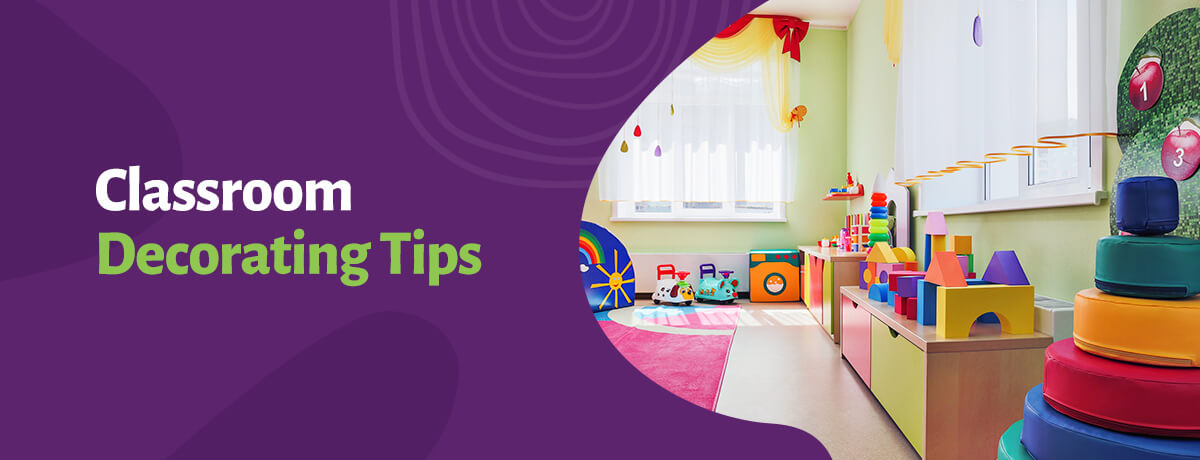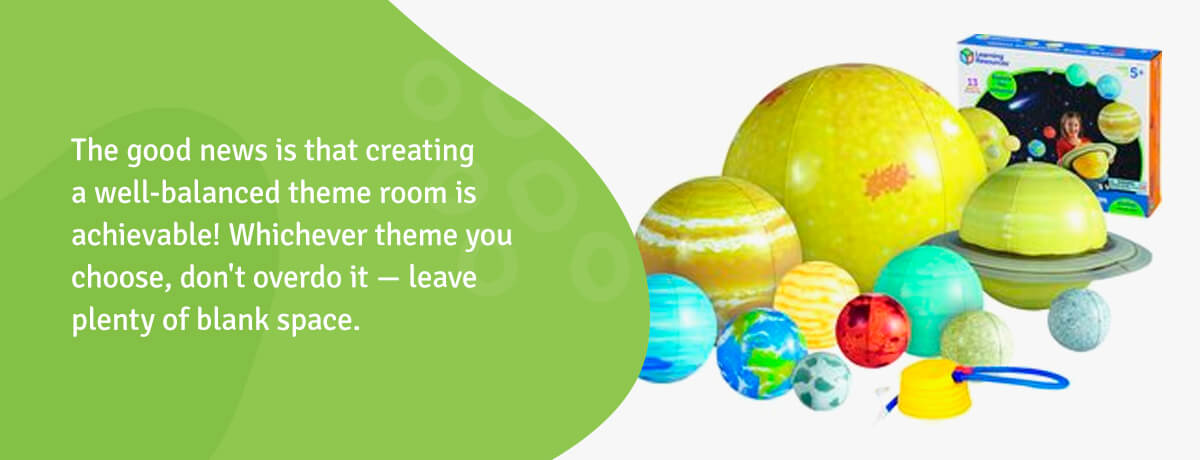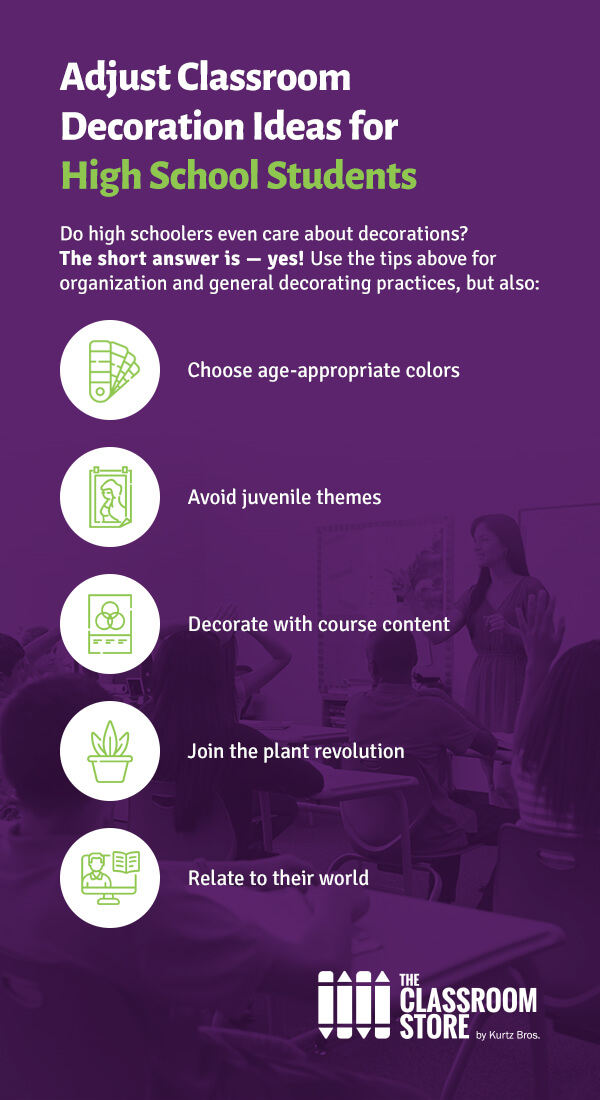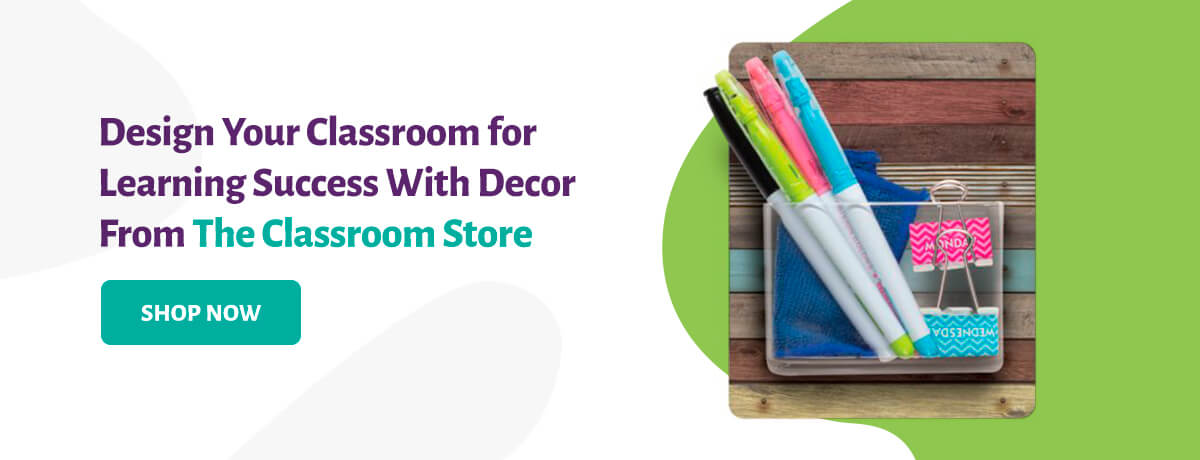Classroom Decorating Tips

Are you a new teacher looking for beginner decorating tips, or a seasoned educator interested in refreshing your decor to improve student achievement?
There are tons of class decorating ideas on the internet, from Pinterest-worthy themes to blog-celebrated designs, and we understand it may feel a little daunting to know where to begin. You might feel tempted to go overboard with the decorations, but more decor isn’t necessarily better. Studies show that heavily decorated rooms disrupt students’ focus, memory and sense of calm — precisely what we don’t want our class to experience.
If you want to design for learning and not merely for looks, you’ve come to the right place! Discover how decorating decisions affect students and how you can set up your class to improve concentration, promote calm and inspire creative thinking.
15 Classroom Decorating Tips
These 15 highly effective classroom decorating tips explain how to decorate a classroom to help your students succeed.
1. Welcome New Students
At the start of the school year, greet students with decor that introduces yourself and establishes class expectations. Before they even enter your classroom, provide a warm welcome with inviting door decor.
Decorate your bulletin board with a welcome banner and “about me” facts so they can get to know their new teacher. Remember to include navigation instruction and classroom rules — large signs for zones and supplies help students acclimate to the environment quickly.
2. Create a Light and Bright Environment
Students in light-filled rooms perform better academically. How much better? A recent study found that students in classrooms filled with natural light scored up to 25% higher on standardized tests than their peers in darker rooms. So remove those curtains and let in the sunlight as much as you can!
Avoid window decor unless glare or outside distractions disrupt students’ learning — in which case, try washable window markers and paints to decorate small areas to still let in the light.
Don’t have windows? Illuminate your room with under-cabinet lighting and task lights. Remove dark colors and keep the room light, bright and airy.
3. Keep It Clutter-Free
When it comes to classroom decor, less is more. A classroom filled to the brim with decor will overstimulate most students. Studies show that learners in heavily decorated classrooms focus less on course objectives than those in sparsely decorated environments.
How much decorating is too much? A recent assessment of 153 classrooms determined students benefit from blank space between decorated areas for visual rest. Banish clutter by following these simple rules:
- Every decor piece should have a purpose — to educate, inspire, instruct, clarify or organize.
- Decorate in moderation, limiting colors and themes.
- Keep 20 to 50% of the available wall space empty and clear.
Use various bins to store resources, big and small. Color-coded storage helps students return items quickly.
4. Label Absolutely Everything
Visual cues empower learners to navigate the classroom to use its resources independently — and put them away when finished! Make it easy for students to locate supplies and remember where to place finished assignments.
- Use words and pictures: Cater to all learning styles with a combination of text and imagery. Use die-cut letters to label resource areas and displays.
- Get creative, but not at the expense of readability: Using a few banners with artsy, themed fonts in the classroom is OK, but fancy fonts are challenging to read in smaller print. Stick with standard fonts for most of your labels.
- Keep labels short and sweet: Avoid wordy labels — scannable text is better. “Colored Pencils” is a superior label to “Please Return All the Multicolored Pencils Here.”
- Label everything: No folder, bin or drawer is too large or small to add a label if it contributes to organization and learning.
- Languages matter: Include color-coded languages for all labels in bilingual and ESL classrooms.

5. Consider Classroom Decoration Themes
To theme, or not to theme? Decorating motifs have their pros and cons.
- Theme pros: Themes simplify color and design choices, visually pull everything together and guide purchasing decisions. A fun theme gets students excited about learning and encourages creativity even in a school that emphasizes standardized tests.
- Theme cons: Themes can become outdated or grow to take over a space quickly, crowding out students’ ability to focus. Floor-to-ceiling decor may look whimsical, but it can distract students from the reason for being there — learning. Educational messaging gets lost in an over-decorated classroom.
The good news is that creating a well-balanced theme room is achievable! Whichever theme you choose, don’t overdo it — leave plenty of blank space. Get inspired with these popular classroom decoration ideas.
- Space: Voyage into the world of STEM — science, technology, engineering and mathematics — with a planetary theme! Use solar system posters to perk up the walls with space facts and suspend lightweight planets from the ceiling for a truly out-of-this-world room.
- Dinosaurs: Take your class to the land before time with dino prints, prehistoric plants and dino decor to celebrate science, archaeology and geology.
- Ocean theme: Is your school near the beach? Design a marine life bulletin board and create an under-the-sea reading corner.
- Literary worlds: Bring books to life in your classroom! From Wonderland to wizarding worlds, students love recognizable, immersive environments. For example, a colorful Dr. Seuss™ theme is easy to accomplish with fanciful pennants, character quotes and Cat in the Hat™ decor.
6. Change It Up
Even if you’ve chosen a decorating motif, it’s wise to periodically update the decor to engage students. Seasonal changes and new displays are a great way to refresh the walls.
Does the thought of redecorating your entire space several times a year feel challenging? Don’t sweat it! When planning your class layout and decor, choose a few high-impact areas for intentional changes — like the door and one bulletin board — and update only those spaces.
For example, you can quickly incorporate these stress-free changes into existing decor.
- Swap for the seasons: Winterize with a snowman door and lively outdoor winter scenes. Fill your bulletin board with flowers and sunshine in the springtime. Seasonal trim sets make changes easy!
- Harness the holidays: Bring holiday cheer to your bulletin board — hop from Valentine’s Day to the Easter Bunny trail with ease.
- Work with, not against, your existing decor: Do you have a forest theme or classroom tree? Add flowers in the spring, autumn-colored leaves in the fall and snowflakes in the winter. Have fun with it, and humor is OK! Add scarves to dinosaurs in the winter, or outfit your science lab skeleton with board shorts and sunglasses in the summer.
7. Curate Your Use of Color
Using every color in the rainbow all over your classroom will overstimulate learners. Keep it simple — select two or three predominant colors for bins, walls and decor to create a unified look.
Let’s dive into the power of color — what scientists call color psychology. Colors can affect student mood and focus very differently, so choose wisely! These are the best colors to use in your classroom.
- Green: Many researchers agree green is the top color for classrooms. This hue promotes calm, concentration and learning retention. Paint a soothing sage accent wall, incorporate refreshing green storage bins and bring nature inside with lush green plants.
- Blue: We’ve all heard the phrase “feeling blue” to describe sadness, but learners associate blue with happiness and peace. Use blue tones to create a tranquil space and enhance alertness.
- White: White walls may sound boring, but they offer a feeling of simplicity, allowing the eyes — and mind — to rest from visual stimulation.
- Off-white, light gray and neutrals: Neutral walls calm the mind and improve attention, allowing added decorations to pop appropriately.
Avoid red for walls — while this color inspires excitement, it can also signal danger and anxiety in students’ minds. Red is a good choice for limited signage or a few essential bins intended to grab immediate attention. Black text on signage is OK, but it’s best to avoid using black on larger areas, as it increases sadness, fear and anger in a classroom setting.
As an alternative to red, use yellow and orange as favorable mood-boosting colors. Yellow increases creativity and positive emotions, while orange commands attention without signaling danger. You can still use other, bolder colors sparingly and intentionally.
8. Educate at a Glance
Visual aids like maps, diagrams and charts appealingly reinforce lesson plans. Informative posters improve student learning, so enhance those walls with beauty and knowledge.
- History posters: Introduce students to civil rights pioneers and creatively display social studies facts about governments, countries, economics and more.
- Language arts posters: Use chatter charts to highlight key terms and writing topics and spice up your students’ writing with an expanded vocabulary display.
- Math posters: Reinforce math basics like the order of operations, math symbols and formulas with informative wall art.
- Science posters: Illustrate science concepts through decor! Vivid signs can help students visualize the unseen — light, waves, force, motion, heat and sound.

9. Capitalize on Classroom Corners
Give your classroom corner a makeover and transform it into a quiet, secluded reading nook or a special location for self-directed individual and small group activities.
Soft furnishings and fabrics dampen noise and reduce distractions, further designating this as a quiet zone. Use beanbags, pillows and colorful carpets to provide a comfortable area for students to sit, read, relax and create.
Decorate the vertical space to zone the area — drape tent-like fabric from the ceiling, hang multicolored pennants or install a whimsical canopy using scalloped-edge awnings featuring stripes, polka dots and other patterns that go with any theme. Speaking of themes, corners are a perfect place to unleash your creative side! From rocketship reading corners to under-the-sea sanctuaries, your students will love the immersive environment you provide in the corner of the classroom.
10. Elevate Your Door Decor
The door is the first and last space students see when they enter and exit your room, so remember to make a lasting impression with this valuable piece of classroom real estate.
The front of the door is a perfect place to introduce yourself as their teacher, emphasize your teaching subject, welcome the class and celebrate your students. Use the back of the door to reinforce course concepts, inspire with positive messaging and encourage personal responsibility.
Decorate the front of your door to give a hint to the theme inside the classroom. And you don’t have to stay on theme all year — feel free to change up your door in fall, winter, spring and summer for an entry that’s always in season. All-in-one door decor kits make door decorating a breeze!
11. Use Eye-Catching Schedule and Assignment Charts
Empower your learners by showing them where to find valuable resources. When everything has a place, you lower the potential for student anxiety because they’ll know where to pick up supplies, what to expect in class and how to return finished assignments.
Keep your most-used files organized by color in a desktop file organizer. Use pocket charts to store folders, assignments and class information within arm’s reach so students can access resources themselves. Place labeled pocket charts in different areas of the classroom for:
- Class schedules and activities
- Daily, weekly and monthly assignments
- Homework folders
- Attendance records
- Extra reading materials
12. Decorate to Motivate
Dress up your walls and encourage a growth mindset with stylish motivational posters! Positive affirmations boost learning and educational success.
Feature images and quotes about inspirational role models to encourage a greater sense of belonging and aspiration in your students — especially when they see their backgrounds, cultures and interests represented. Celebrate diverse heroes and civil rights pioneers, and strive for inclusion, but avoid stereotypical representation, which can lower self-esteem and feelings of community worth.
13. Reinforce Classroom Rules and Procedures
Make it easy for students to understand the classroom rules and expectations from Day One with large posters placed throughout the classroom. Visual reminders set the class tone for students to follow procedures.
Design an FAQ area for provided answers to repeated questions. Add friendly procedure signs, like a sign over the sink to remind students to clean and dry paintbrushes thoroughly before returning them to drawers. Build self-esteem with decorative banners that remind students that they can improve their skills with dedication, positive mentality and motivation to learn.
14. Invite Students to Participate in the Process of Decorating
Want to know how to get students excited about classroom decor? Let them participate! Students feel pride and investment in a classroom space when they can see how they contributed to the decor.
Rotate groups of students to help with each season’s bulletin board change. Break out the art materials and ask the class to make snowflakes or holiday ornaments to decorate the room. Encourage students to design motivational posters and display them on the wall in a place of honor.

15. Adjust Classroom Decoration Ideas for High School Students
As a high school teacher, is it worth it to decorate your classroom? Do high schoolers even care about decorations? The short answer is — yes!
Many teachers wonder if decorating is too childish for their high school students. Rest assured that even teenagers love nicely decorated spaces. They may never tell you, but trust us — they do!
Use the tips above for organization and general decorating practices, but adjust your themes, colors and decor choices for the teenage crowd:
- Choose age-appropriate colors: Elevate your color scheme from crayon-like elementary-school tones to concentration-boosting colors like blues and greens. You can still add pops of color, but be sure to keep your audience’s age in mind.
- Avoid juvenile themes: If you still want a motif, choose one that makes sense for your learners. Skip the elementary-age cartoons. Instead, use themes to draw attention to the subject you teach — decorate with giant posters of critically acclaimed books for a literature class or portraits of historical figures for a social studies room.
- Decorate with course content: Posters and wall art should reinforce lessons and educate at a glance.
- Join the plant revolution: Millennials may have started the social media plant craze, but teens have joined the botanical hype as well. Add classroom plants in fun pots and include your students in their watering to give them a sense of ownership in the space.
- Relate to their world: What shows do your students watch? What games do they play? How do they communicate? Consider what is popular for your teens and use that. Inspire grins from humorous decor additions — print classroom-appropriate memes, post punny rule reminders with videogame characters and incorporate pop-culture references to garner attention and drive home lesson plans.
 Design Your Classroom for Learning Success With Decor From The Classroom Store
Design Your Classroom for Learning Success With Decor From The Classroom Store
Do you need help turning your classroom into an eye-catching education destination? The Classroom Store has you covered! You can quickly outfit your entire room, from wall art to storage bins, with our convenient one-stop online store.
Our massive selection of over 15,000 classroom resources saves you time shopping and decorating so you can get back to the thing you love most — teaching! As your classroom partner, we pride ourselves in providing teachers with decorative and organizational resources that are as beautiful as they are functional.
Explore our top-quality classroom decorations today, or contact us to learn more about how The Classroom Store can help you design a customized, cohesive classroom!

